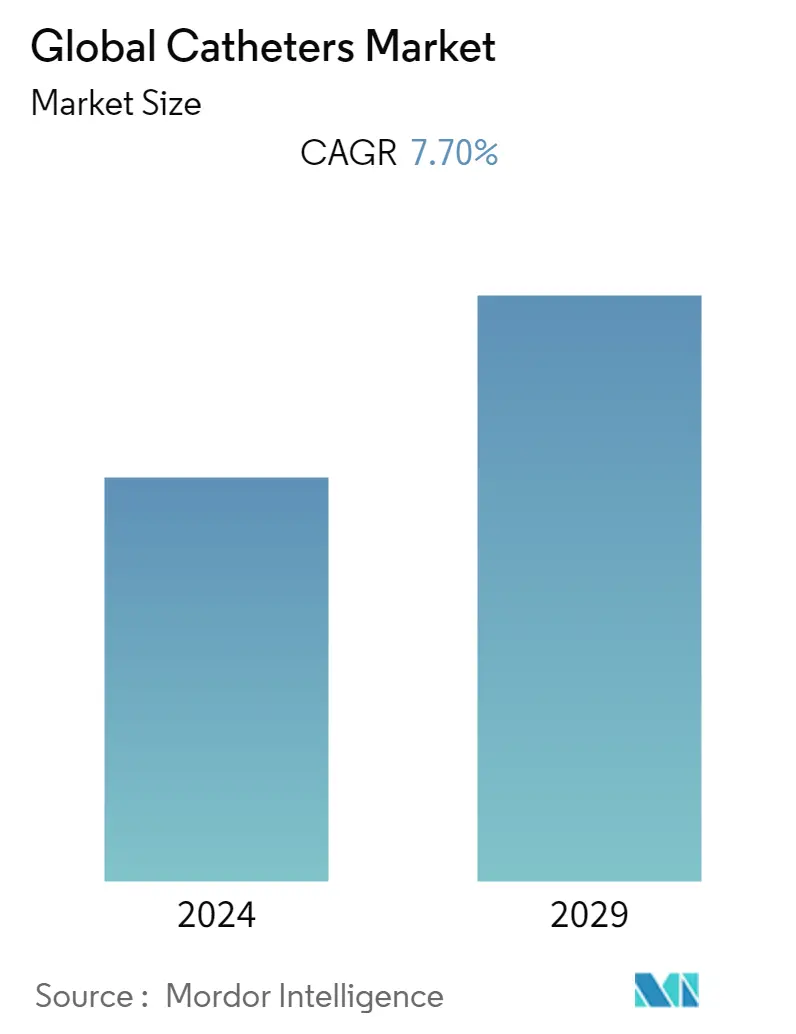Market Size of Global Catheters Industry

| Study Period | 2019 - 2029 |
| Base Year For Estimation | 2023 |
| Forecast Data Period | 2024 - 2029 |
| CAGR | 7.70 % |
| Fastest Growing Market | Asia Pacific |
| Largest Market | North America |
Major Players
*Disclaimer: Major Players sorted in no particular order |
Need a report that reflects how COVID-19 has impacted this market and its growth?
Catheters Market Analysis
The Catheters Market is poised to register a CAGR of 7.7% during the forecast period (2022-2027).
The rising COVID-19 cases across the world and the lockdown situation have had a significant impact on the market, initially due to on-hold services, such as treatment, diagnostic, and surgical services, to prevent the spread of COVID-19. However, the growing number of COVID-19 cases around the world has helped in increasing the number of in-patient admissions. As governments and healthcare institutions were found to increase efficient medical treatment to treat COVID-19 patients, the usage of catheters witnessed tremendous demand in hospitals and emergency clinics. Patients with suspected or confirmed diagnoses of COVID-19 were being treated with the help of catheters, and hence, the demand for these products remained huge throughout the pandemic. Moreover, product launches amid the pandemic were also anticipated to have a positive impact on the market's growth. For instance, in April 2020, Bactiguard introduced a new urinary catheter, the BIP Foley TempSensor, for continuous temperature monitoring in patients. Such factors collectively bolstered the market's growth over the pandemic phase.
The market is expected to observe good growth due to the increasing burden of cardiovascular, neurologic, and urological disorders; increasing usage of minimally invasive procedures; and the rising demand for antimicrobial catheters. Rising chronic disorders have become the most dominant cause of mortality and morbidity globally. According to the Brain Aneurysm Foundation in March 2021, globally, approximately 500,000 deaths are caused by brain aneurysms every year, and half of such individuals are aged 50 or below. The annual rate of rupture is around 8-10 people per 100,000 or about 30,000 people in the United States. Thus, with the increasing prevalence of neurovascular disorders, the demand for neurovascular catheter devices is also anticipated to rise.
Furthermore, the growing number of minimally invasive procedures is expected to increase the demand for catheters worldwide. These procedures have increased patients' preference for less invasive procedures, which is expected to favor the market's growth. In addition, rising initiatives from the key market players for the launch of their products are expected to propel the market's growth further. For instance, in July 2021, Medtronic plc launched its Prevail drug-coated balloon (DCB) catheter in Europe following the CE (Conformité Européenne) mark. The newest coronary DCB on the market, the Prevail DCB, is used during percutaneous coronary intervention (PCI) procedures to treat narrowed or blocked coronary arteries in patients with coronary artery disease (CAD). This will lead to increased adoption of such catheters to treat cardiovascular disease, and the market growth will benefit from rising minimally invasive procedure trends.
Hence, with the increasing number of surgeries being performed due to rising cases of chronic diseases, the demand for catheters is expected to increase in the near future, thereby driving the market's growth. However, complications associated with catheters and the presence of substitutes may hamper the growth of the market.
